 |
|
||||||||||||||
Vol. 19, No. 4, JULY 25, 2006 |
|||||||||||||||
The Friday Program
Rob was complimentary about the level of international involvement and hands-on projects sponsored by the BBRC. “Using multiplier of RI grants, a little money goes a long way to make these projects successful,” Rob observed. “Rotary is the vehicle which has allowed me — just an ordinary person — through Rotary, to make things happen.” 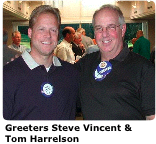
President Jim opened the meeting, introducing Tom Harrelson, who delivered the invocation and led the pledge to the flag. Steve Vincent greeted visiting Rotarians and other visitors.
Phil asked the three major chairs to rise with him. Dick Brown chaired the Golf Committee and raised $10,200 net for the project. Chuck Barnes, chairing Corporate Sponsors, reported a gross of $39,800, which netted out at $32,000. And Bob McKorkle, who chaired the auction following the golf tourney added another $11,000. Salvatori said the final tab should be over $55,000, “a great accomplishment on our first re-invention of our annual Golf Outing. Many members contributed their time and talents to make this all happen. Everyone who participated gets the praise.” For his part in making the Auction work, along with auctioneer Tim Leahy, Bob McKorkle received the Rotarian of the Month award for July. Bob, a past BBRC president has maintained 100% attendance and is always ready to help when asked.
Five Rotary clubs fielded teams, including the host BBRC. Shooting the low score was the Emerald City team with a 62. The other clubs competing were Bellevue Noon, Bellevue Sunrise, Sammamish and the Bellevue Breakfast Rotary Club. ROTARY DIVISION RESULTS
Ten teams were picked to compete in the Handicap Division based on the lowest handicaps. The winning squad was captained by the BBRC’s Jay Powers, which won on a tie-breaker with the team captained by Greg Hendershott. Powers group shot a 59 gross, 58 net to take the prize. HANDICAP DIVISION RESULTS
WOMEN'S DIVISION RESULTS
OPEN DIVISION RESULTS
Wendi Fischer Re-Classification Talk
Wendi said the program is designed for 2nd and 3rd graders, and she’s known as the "Chess Lady," when she comes to visit classrooms. Wendi next recruited Rourke O’Brien’s son, Tim, to run a quiz about Chess.
There were brochures on the table telling more of the story of the American Foundation for Chess. A spring quarter project was born at the April 1 Retreat in Leavenworth: to identify the Mission, the Values and the Vision of the Bellevue Breakfast Rotary club. This was a project of BBRC Strategic Planning, with Jim Zidar as chair and Tom Smith as facilitator. Several members devoted many hours to make this report to the membership. Tom touched on the elements of the plan:
The committee worked doggedly on a Values Statement: “The BBRC is an inclusive, fund-loving, caring group of community leaders, coming together to share a common sense of service and ethics to positively impact lives locally and abroad.” The Mission – What we do and how we do it? Will our fundraising define our mission? What things do we do that are 1) Indispensable? 2) Important? or 3) Those we could discard? From this thinking came the Mission statement: “The BBRC changes lives in our local and world communities through service and financial support.” The Vision – Who do we want to be? What image do we want of ourselves? What image do we want in the eyes of others? Thus, the Vision Statement: “The vision of the BBRC is to cultivate a dynamic membership that enhances our club values to serve our local and world communities, providing systemic and enduring change.” In addition to the statements, came guidelines for long-term objectives. “To implement the MVV process, we recognized the wisdom of giving multi-year guidance, giving consistency of action from one presidency to the next,” Tom said. “From our deliberations, came a series of ‘filters.’ We found these invaluable in our work to adopt our statements, so much so that these filters can be used by all our committees to help them determine whether our projects meet our stated standards. It allows us to weigh alternatives against each other,” Tom explained.
The project received unanimous approval from the Board of Directors, with the assignment that Mr. Smith report the results to the club membership. That, he did Friday. For Tom’s stellar performance as the facilitator on this project, he received the Rotarian of the Year award at the Rotating the Wheels dinner. Not many organizations have the built-in talent this one has, and the MVV project is a reminder of that fact. Two New Members Proposed: Bowen & Luksetich The Board recently approved publication of two new applications. Robert “Bob” Bowen, sponsored by Bill Brooks and co-sponsored by Jan Nestler, joins the BBRC with a proposed classification of “World Relief.” Bob has a world of experience helping people in all parts of the planet. He is Executive Director of World Vision, headquartered in Federal Way. World Vision is a non-profit international relief organization that has a long history of advocating for children. Who is World Vision? The answer is: “We are a Christian relief and development organization dedicated to helping children and their communities worldwide reach their full potential by tackling the causes of poverty.” Bob and his wife Janice live in Issaquah. They have two children, Aaron, 19, and Sam, nearly 13. Bob has served as Chaplain for the City of Bellevue and is a Board member of Eastside Fire & Rescue. He is also active with Friends of Youth and a member of NDOA (National Development Officers Association), the Federation of Fire Chaplains, and the Foursquare Church chaplains. Bob enjoys family vacations, community service and international missions. He is a member of the Klahanie Fitness Club and counts golf, fly fishing and jogging among his sports recreational interests. Jon E. Luksetich, sponsored by Steve Lingenbrink and co-sponsored by Rourke O’Brien, is proposed to join the BBRC with a classification of “Business Solutions.” Jon works for Key Solutions, a business-supply chain consultant in Kirkland. Jon’s position is Business Consultant. Jon has been involved with Habitat for Humanity and is a member of Holy Family Church. He is a member of APICS, Boy Scouts of America and Phi Kappa Theta Fraternity. He enjoys biking, hiking, camping and tennis, and he lives in Kirkland with his wife Michelle and their two children, Jon (18) and Elizabeth (14). Jon has attended several Rotary meetings and finds the BBRC well-suited to his interests. While attending a BBRC meeting a couple of weeks ago, he was recruited as a photographer when Jim Kindsvater and John Mix were involved with the induction of Ernie Hayden. Jon jumped right in! Questions or comments? Members are officially notified of these two applications upon publication. If there are questions or comments, please contact (Ph 425-451-8036) prior to Thursday, July 28, at 3:00 p.m. The Friday Program
Rob was complimentary about the level of international involvement and hands-on projects sponsored by the BBRC. “Using multiplier of RI grants, a little money goes a long way to make these projects successful,” Rob observed. “Rotary is the vehicle which has allowed me — just an ordinary person — through Rotary, to make things happen.”
Rob showed a video of his ‘Return to Nepal,’ with pictures and audio produced by him. This first-person production showed the various projects he’s been involved in and the wonderful photos of the youngsters of the country. He has partnered with Nepalese Rotary clubs and Rotaract clubs to complete his projects. Katmandu, Nepal’s capital city is the site of one such project for hearing-disabled children. He’s also adopted an orphanage, helping them receive much needed basics.
For his presentation, Rob Rose received a certificate showing that a donation to Rotary First Harvest has been made in his name, representing 1400 pounds of fresh food to local food banks. Thanks to Jim Gordon for his introduction. Geographic Gee Whizzes Alaska: More than half of the coastline of the entire United States is in Alaska. Amazon: The Amazon rainforest produces more than 20 percent of the world's oxygen supply. The Amazon River pushes so much water into the Atlantic Ocean that ~ more than one hundred miles at sea, off the mouth of the river one can dip fresh water out of the ocean. The volume of water in the Amazon River is greater than the next eight largest rivers in the world combined and three times the flow of all rivers in the United States. Antarctica: Antarctica is the only land on our planet that is not owned by any country; 90% of the world's ice covers Antarctica. This ice also represents 70% of all the fresh water in the world. As strange as it sounds, Antarctica is essentially a desert. The average yearly precipitation is about two inches. Although covered with ice (all but 0.4 percent of it), Antarctica is the driest place on the planet, with an absolute humidity lower than the Gobi desert. Brazil: Brazil got its name from the nut, not the other way around. Canada: Canada has more lakes than the rest of the world combined. Canada is an Indian word meaning "Big Village." Chicago: Next to Warsaw, Chicago has the largest Polish population in the world. Detroit: Woodward Ave. in Detroit, Michigan, carries the designation M-1, because it was the first paved road anywhere. Damascus: Damascus, Syria, was flourishing a couple of thousand years before Rome was founded in 753 BC, making it the oldest continuously inhabited city in existence. Istanbul: Istanbul, Turkey is the only city in the world located on two continents. New York City: The term "The Big Apple" was coined by touring jazz musicians of the 1930's who used the slang expression "apple" for any town or city. Therefore, to play New York City is to play the big time ~ The Big Apple. There are more Irish in New York City than in Dublin, Ireland, more Italians in New York City than in Rome, Italy, and more Jews in New York City than in Tel Aviv, Israel. Wilderness: Percentage of Africa that is wilderness 28%. Percentage of North America that is wilderness 38%. Ohio: There are no natural lakes in the state of Ohio, every one is man-made. Rome: The first city to reach a population of 1 million people was Rome, Italy, in 133 B.C. There is a city called Rome on every continent. Siberia: Siberia contains more than 25 percent of the world's forests. SMOM: The smallest sovereign entity in the world is the Sovereign Military Order of Malta (SMOM). It is located in the city of Rome, Italy, has an area of two tennis courts, and as of 2001 has a population of 80, 20 less people than the Vatican. It is a sovereign entity under international law, as is the Vatican. Sahara Desert: In the Sahara Desert, there is a town named Tidikelt, which did not receive a drop of rain for ten years. St. Paul: St. Paul, Minnesota was originally called Pigs Eye after a man named Pierre "Pig's Eye" Parrant who set up the first business there (bootlegging). Roads: Chances that a road is unpaved in the USA ~ 1 percent; chances that a road is unpaved in Canada ~ 75 percent. United States: The Eisenhower interstate system requires that one mile in every five must be straight. These straight sections are meant to be usable as airstrips in times of war or other emergencies. |
|||||||||||||||
|

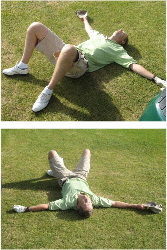

 Rob Rose, a Bellevue Lunch club Rotarian, had Rotary change his life forever. Introduced to international projects, Rob made a call to help out an organization and was off to India and Nepal. This was in 1996 and “that trip to Nepal really made a complete change in my life. Since that time, I’ve coordinated eight matching grants and several club grants for many projects in that beautiful country.”
Rob Rose, a Bellevue Lunch club Rotarian, had Rotary change his life forever. Introduced to international projects, Rob made a call to help out an organization and was off to India and Nepal. This was in 1996 and “that trip to Nepal really made a complete change in my life. Since that time, I’ve coordinated eight matching grants and several club grants for many projects in that beautiful country.” 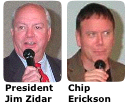 Chip Erickson brought a guffaw to the crowd with his description of some of the “finds” discovered while doing the Adopt-a-Highway Clean-up project. The work is sponsored by the BBRC’s Preserve Planet Earth committee, of which Chip is chair. “We’ll meet at the SE 8th park-and-ride lot at 9:00 a.m. this coming Saturday, July 29. During our last clean-up, one of our crew found an IRS refund check. We called the person listed on the check, and he practically came out of the phone in gratitude. Seems he was whizzing down 405 and the check blew out the window. He said he went back and searched but obviously couldn’t find it.” Another successful story of Rotary helping the community!
Chip Erickson brought a guffaw to the crowd with his description of some of the “finds” discovered while doing the Adopt-a-Highway Clean-up project. The work is sponsored by the BBRC’s Preserve Planet Earth committee, of which Chip is chair. “We’ll meet at the SE 8th park-and-ride lot at 9:00 a.m. this coming Saturday, July 29. During our last clean-up, one of our crew found an IRS refund check. We called the person listed on the check, and he practically came out of the phone in gratitude. Seems he was whizzing down 405 and the check blew out the window. He said he went back and searched but obviously couldn’t find it.” Another successful story of Rotary helping the community!  President-Elect Phil Salvatori, the uber-seer of all things Fundraising, happily reported to the club that last week’s Golf Classic was a “roaring success.”
President-Elect Phil Salvatori, the uber-seer of all things Fundraising, happily reported to the club that last week’s Golf Classic was a “roaring success.” 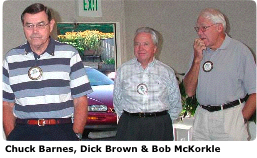 As for the Golf Classic itself, Chief Statistician Ted Ederer compiled all the information to make the awards for golfing excellence. There were four divisions competing for trophies: Rotary Division, Handicap Division, Women’s Division and Open Division. One-hundred forty golfers registered and competed, capping off one of the more successful golf outings sponsored by the BBRC.
As for the Golf Classic itself, Chief Statistician Ted Ederer compiled all the information to make the awards for golfing excellence. There were four divisions competing for trophies: Rotary Division, Handicap Division, Women’s Division and Open Division. One-hundred forty golfers registered and competed, capping off one of the more successful golf outings sponsored by the BBRC. 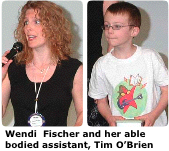 “Six years ago, I joined Rotary. I was single;, now I’m married and have two children. My first career was teaching, and when I joined the BBRC, I worked as a TV program producer for five years. One day, I did a story on the American Foundation for Chess, with the organization’s director, Rourke O’Brien. He encouraged me to look into A4Chess. I did, and fell in love with the program. I am now the Vice President for Scholastics for Chess.”
“Six years ago, I joined Rotary. I was single;, now I’m married and have two children. My first career was teaching, and when I joined the BBRC, I worked as a TV program producer for five years. One day, I did a story on the American Foundation for Chess, with the organization’s director, Rourke O’Brien. He encouraged me to look into A4Chess. I did, and fell in love with the program. I am now the Vice President for Scholastics for Chess.” The information developed will be used in new member orientation, published in the Reveille, used to inform those seeking grant applications what our ground rules are, and to communicate with our various partners how the BBRC sees itself.
The information developed will be used in new member orientation, published in the Reveille, used to inform those seeking grant applications what our ground rules are, and to communicate with our various partners how the BBRC sees itself. 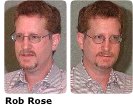 Rob Rose, a Bellevue Lunch club Rotarian, had Rotary change his life forever. Introduced to international projects, Rob made a call to help out an organization and was off to India and Nepal. This was in 1996 and “that trip to Nepal really made a complete change in my life. Since that time, I’ve coordinated eight matching grants and several club grants for many projects in that beautiful country.”
Rob Rose, a Bellevue Lunch club Rotarian, had Rotary change his life forever. Introduced to international projects, Rob made a call to help out an organization and was off to India and Nepal. This was in 1996 and “that trip to Nepal really made a complete change in my life. Since that time, I’ve coordinated eight matching grants and several club grants for many projects in that beautiful country.” 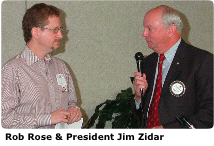 District Governor Mike Montgomery told Rotarians at Rob’s club to “get in the game — the game of international involvement. This builds bridges between cultures, builds legacies, and promotes world peace.”
District Governor Mike Montgomery told Rotarians at Rob’s club to “get in the game — the game of international involvement. This builds bridges between cultures, builds legacies, and promotes world peace.” 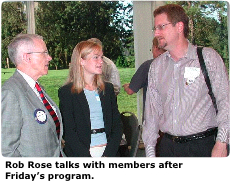 Rob concluded: “I pinch myself that I’ve had this opportunity to take the step and get involved. Anything can happen when you take that step. As Rotarians, we see humanitarian needs and go to the far places of the globe without an agenda. We recognize and respect other cultures. So, you need to ask yourself: ‘What would happen if you would get in the game?’”
Rob concluded: “I pinch myself that I’ve had this opportunity to take the step and get involved. Anything can happen when you take that step. As Rotarians, we see humanitarian needs and go to the far places of the globe without an agenda. We recognize and respect other cultures. So, you need to ask yourself: ‘What would happen if you would get in the game?’”